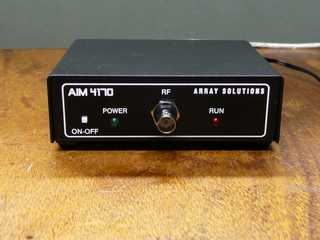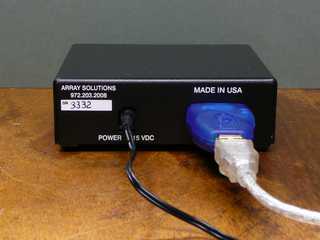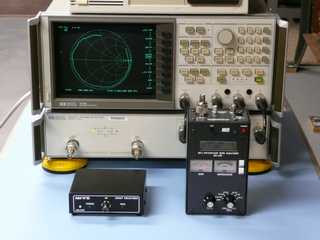I purchased an AIM4170 Antenna Analyzer in Feb. 2008 to compliment an HP8753B, 3 GHz. two port vector network analyzer, with HP85046A S-parameter test set, and an MFJ-269 antenna analyzer. I have spent time comparing the instruments and am extremely happy with the accuracy of the AIM4170 when used properly. What follows are some measurements I made on the AIM4170 and how to use it. The opinions on these pages are totally mine and I am in no way affiliated with Array Solutions who sells the product or Bob Clunn, W5BIG who designed it other than as a customer.
All network analyzers, antenna analyzers, and SWR meters make the same type of measurement which is a measurement of RF impedance. However the similarity ends quickly.
SWR meters need an external signal source (transmitter) and measure reflection coefficient, at the point of SWR meter itself, which is then displayed as standing wave ratio (SWR). To an SWR meter (in a 50 ohm circuit), impedances of 25+j0, 100+j0, 40+j30, 40-j30, 29+j17 ohms, etc. all represent impedances which produce reflection coefficients of 1/3 which are the same as SWRs of 2.0:1. This measurement while sufficient to tell if your transmitter is going to be happy will not do much to help you design a matching network.
Antenna analyzers are like SWR meters with an internal signal source. Some analyzers such as the MFJ-259/269 can measure the phase of the RF impedance, at the point of the meter itself, but can't distinguish between 40+j30 and 40-j30 ohms. For most circuits the phase can be determined by slightly changing the frequency and noticing if the reactive part of the impedance increases or decreases. Some newer antenna analyzers do not have this limitation.
A network analyzer is a device with an internal signal source that generally needs to be calibrated (increasing the accuracy) in order to be able to measure impedances at some location other than at the instrument itself which is extremely convenient and important. Network analyzers come in scalar which only measure reflection coefficient and vector analyzers which measure the phase of the RF impedance. Scalar analyzers are used primarily in production environments while vector analyzers come in 1 port, 2 port, and hybrid 1 port TX, 2 port recieve versions. Analyzers with 2 ports are used to design filters and can measure impedances and RF transmission from one port to the other. True 2 port analyzers can have either port be the signal source.
SWR meters need an external signal source (transmitter) and measure reflection coefficient, at the point of SWR meter itself, which is then displayed as standing wave ratio (SWR). To an SWR meter (in a 50 ohm circuit), impedances of 25+j0, 100+j0, 40+j30, 40-j30, 29+j17 ohms, etc. all represent impedances which produce reflection coefficients of 1/3 which are the same as SWRs of 2.0:1. This measurement while sufficient to tell if your transmitter is going to be happy will not do much to help you design a matching network.
Antenna analyzers are like SWR meters with an internal signal source. Some analyzers such as the MFJ-259/269 can measure the phase of the RF impedance, at the point of the meter itself, but can't distinguish between 40+j30 and 40-j30 ohms. For most circuits the phase can be determined by slightly changing the frequency and noticing if the reactive part of the impedance increases or decreases. Some newer antenna analyzers do not have this limitation.
A network analyzer is a device with an internal signal source that generally needs to be calibrated (increasing the accuracy) in order to be able to measure impedances at some location other than at the instrument itself which is extremely convenient and important. Network analyzers come in scalar which only measure reflection coefficient and vector analyzers which measure the phase of the RF impedance. Scalar analyzers are used primarily in production environments while vector analyzers come in 1 port, 2 port, and hybrid 1 port TX, 2 port recieve versions. Analyzers with 2 ports are used to design filters and can measure impedances and RF transmission from one port to the other. True 2 port analyzers can have either port be the signal source.
It is a computer driven single port true vector network analyzer for RF frequencies up to 170 MHz.
Analyzer Background
So What is the AIM4170?
Pros of the AIM4170?
Cons of the AIM4170?
•
Can calibrate measurements to the end of a cable, through a filter, and/or a coax switch box, etc. This is extremely important and valuable.
•
Very accurate when used with supplied calibration standards. More accurate at frequencies above HF especially with impedances representing high SWRs when calibrated with precision standards and care is taken to set the reference plane.
•
Very easy to capture or print flexible plots of all normal parameters such as SWR, Zmag, Rs, Xs, Theta, and Return Loss.
•
Features similar to big analyzers such as saving calibrations, line extension to set the reference plane (software ver. 6.55 and later), and setting reference impedance for SWR.
•
Very portable when used with a small laptop PC and a small battery to power the AIM4170.
•
Usable as a stable RF signal generator.
•
Ultimate accuracy of instrument limited by supplied calibration standards.
•
Input impedance of AIM4170 itself is not 50 ohms (110 ohms). This is seldom a problem but is worth knowing.
•
Interface to PC is RS-232 which requires a USB to RS-232 adapter for newer PCs.
•
Needs computer for any control. This is really both a pro and con.
•
Output signal level not adjustable.
Measurements I made on the AIM4170 begin on the next page.
Page content last updated Apr. 7, 2008
Copyright © 2008 Larry Benko, W0QE
About 90% of the measurements I make can be made more easily, with adequate accuracy, on the AIM4170 than on my HP8753B. I do a lot of mobile operating including contesting and the ability to make mobile antenna measurements from inside the car in preparation for an event with the AIM4170 is much easier than extending a cable outside from my HP VNA in the basement and trying to choke the coax to get accurate measurements. Since the HP8753B weighs 80 lb. and getting plots from it is somewhat of a chore the AIM4170 is a welcome addition.
Click on any pic for higher resolution image
I can not emphasize enough the value of being able to measure the impedance at the antenna with the analyzer located at the other end of the coax. The impedance at the antenna is always different from the impedance at the end of the coax unless the impedance of the antenna matches the characteristic impedance of the coax at all frequencies which is not possible. This is often why certain lengths of coax are problematic in some installations.



